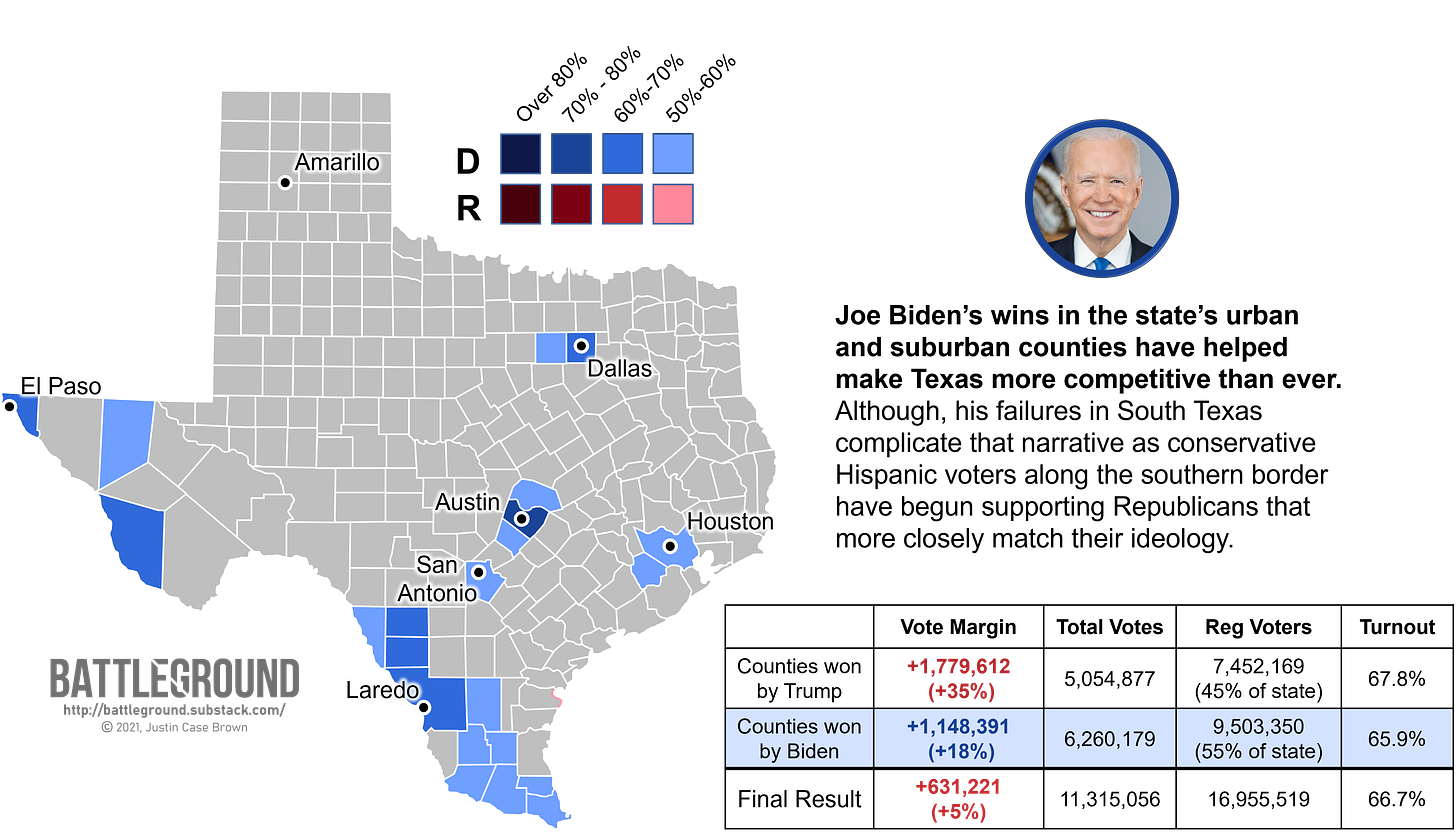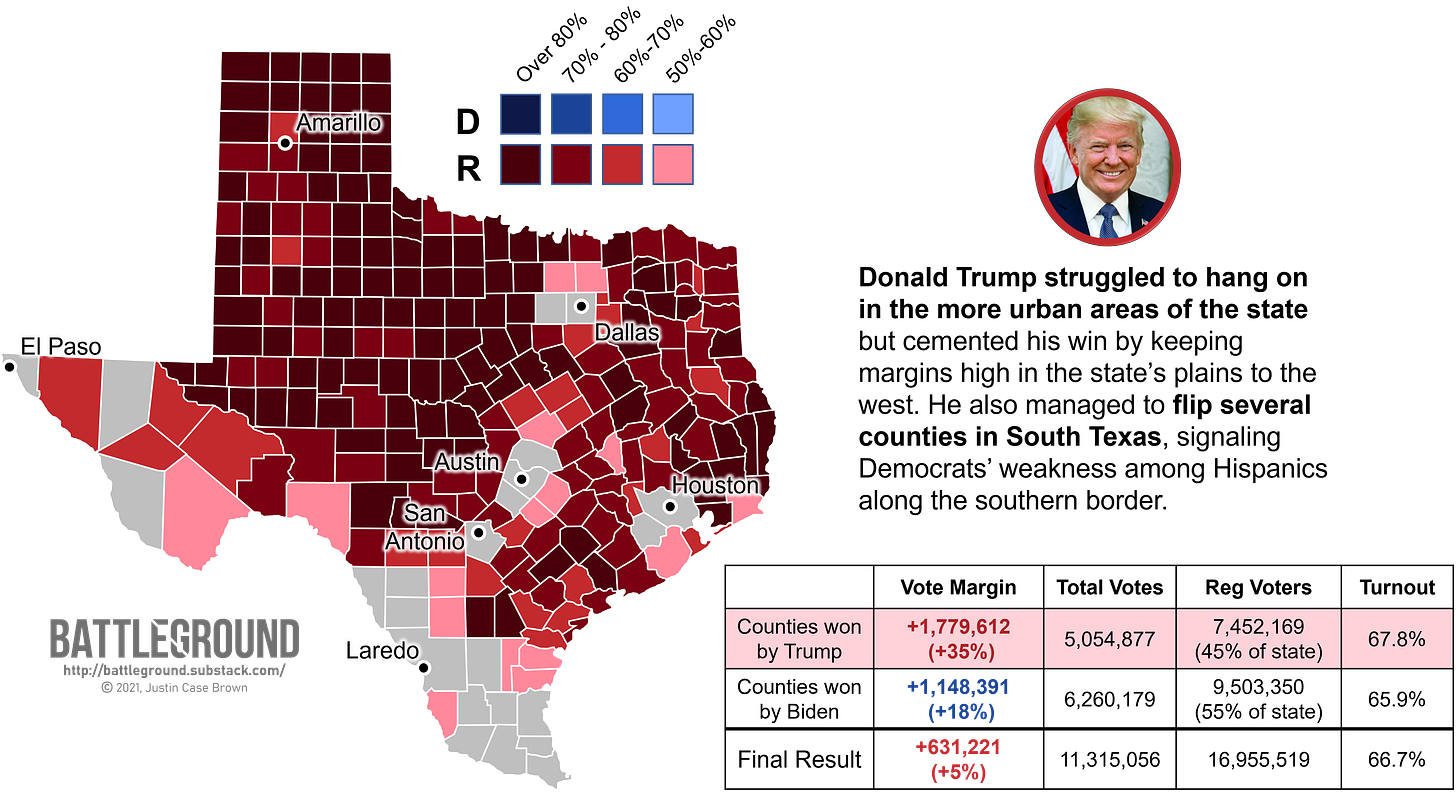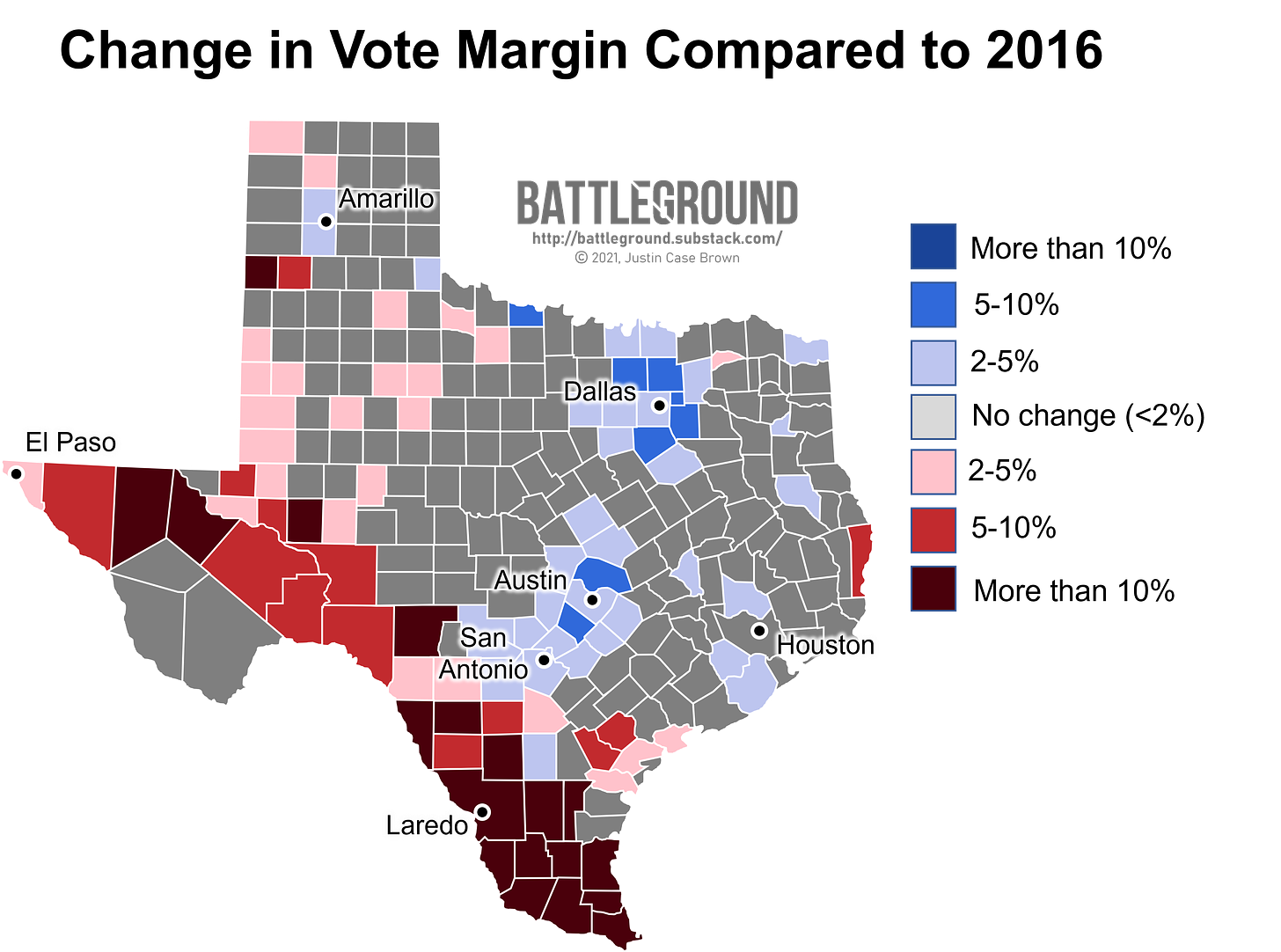Howdy partner!
For the rest of the week, we’ll be continuing our exploration through the South by following the Red River from east to west, starting in Texas!
Topline Takeaways
Donald Trump flipped a total of eight counties in 2020, most of which lie in the Democratic stronghold of South Texas.
Joe Biden flipped three counties and increased margins in the state’s urban counties, reducing the statewide margin to just under 6 points.
Conservative Hispanics in South Texas have historically supported Democrats but the national Democratic party’s calls to defund the police and transition away from fossil fuels have influenced many to rethink their vote.
In-Depth Insights
Joe Biden’s base in Texas begins in “The Big Five,” the counties holding the state’s five largest cities: Houston, San Antonio, Dallas, Austin and Fort Worth. Voters in these counties alone voted for Biden over Trump by a margin of over 800,000 votes. Democrats are bullish on their prospects largely due to population changes in these areas as “The Big Five” were regularly listed as some of the fastest growing counties in the nation during the 2010s. While Republicans often boast that this growth is due to the popularity of conservative ideals, they also warn that the state’s recent blue tilt is due to liberals (primarily Californians) invading Texans’ communities across the state. (Current governor Greg Abbott literally ran on the slogan “Don’t California my Texas!” in 2018.) This narrative has been especially attractive to both right-wing commentators and out-of-state politicos in explaining how Democrats have been able to close the gap in statewide elections over the past twenty years. Digging a bit deeper proves that this explanation is hollow, resting more on assumptions and partisan conspiracy rather than fact.
In the 2018 midterms, the nation was gripped by Beto O’Rourke’s run against Sen. Ted Cruz as the Democratic challenger came within 3 points of the Republican incumbent, marking the closest senate race in Texas since 1978. Exit polling showed that O’Rourke’s support was primarily from Texas natives and it was instead Texas transplants who supported the Republican candidate by a margin of 57-42. Other polls have supported this same trend: in 2013 a poll specifically questioning California ‘expats’ showed that a majority (57%) of these new Texas residents identified as conservatives whereas only 27 percent identified as liberals. Even 2016 presidential exit polling bucks national narratives of liberals ‘tainting’ Texas: native Texans were more split between Trump and Clinton (45-38, 7-point margin) than transplants (47-35, 12-point margin). Looping in recent pop culture stories of Californians moving to Texas helps provide an even more colorful picture. Tried-and-true, deep-blue celebrities aren’t the ones extolling the virtues of Texas, instead it’s libertarian icons like Elon Musk and Joe Rogan who are decamping California for Texas.
The truth on the ground is that the political attitudes of Texas natives are changing but this poses both an opportunity and a problem for Texas Democrats as their long-time stronghold along the southern border is beginning to crack.
Donald Trump’s strategy of defeating Biden in Texas could be described as “death by a thousand cuts.” He won over 200 of Texas’s counties, most of which are rural and sparsely populated. In many of these counties, particularly those in the state’s western plains, he garnered as much as 90% of the vote. While the populations of these counties is small and shrinking, he still bested Biden by a 43-point margin, totaling over 1.7 million votes. The big surprise for many was Trump’s increased popularity with the state’s Hispanic population, particularly among a subgroup that identifies themselves as ‘Tejanos:’
The Tejano community in South Texas traces its ancestral roots back to Spanish colonists settling in the Rio Grande Valley. Today, many of these voters do not identify as “people of color” and instead largely mark “White” after also marking the “Hispanic or Latino” box on forms that ask for their race and ethnicity. While many on the left gambled that Trump’s incendiary rhetoric toward Mexican American immigrants would alienate these voters, many on the ground saw it differently:
-U.S. Rep Vicente Gonzalez (D, TX-15)
The reality is that this community is deeply patriotic, religious and socially conservative. As the national Democratic party moves further left, voters in South Texas are increasingly noticing that they share more in common ideologically with Republican candidates than Democrats. After persistent outreach from Republican operatives, many voters finally made the switch in the 2020 election.
-Sergio Garcia-Rios, professor of government and Latino studies at Cornell University.
Forecasting the Future: While Democrats are salivating at the prospect of Texas becoming a swing state, the progressive wing of the party is proving to be a liability in the historically Democratic stronghold of South Texas. Two of the primary job sectors in South Texas are the oil industry and law enforcement. Progressive Democrats’ calls to defund the police and transition away from fossil fuels cut like a knife through the heart of South Texas and create significant headwinds for Democratic candidates running in districts covering these areas. Much like Hillary Clinton’s 2016 comments in coal country, national Democrats’ rhetoric on these issues was repellent for South Texas voters.
-Gilberto Hinojosa, chair of the Texas Democratic Party
Looking down the ballot, South Texas saw US House races get more competitive in 2020. While Democrats held onto all of their seats, they were stunned by a close call in the state’s 15th congressional district. Republican candidate Monica De la Cruz-Hernandez came within 3 points of Democratic incumbent Vicente Gonzalez who won his previous elections by margins of 10 points or more. Republicans are capitalizing on this opening as a way to hold onto the state in statewide elections and retake the majority in Congress.
-George P. Bush, son of Jeb Bush, commissioner of the Texas General Land Office





